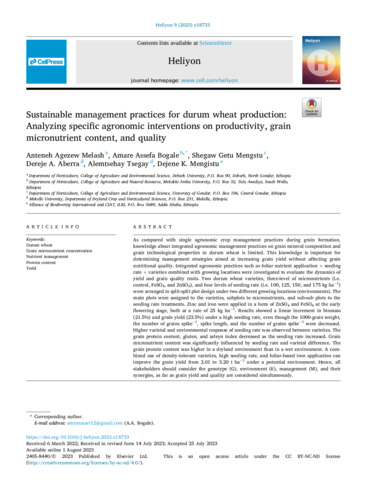Sustainable management practices for durum wheat production: Analyzing specific agronomic interventions on productivity, grain micronutrient content, and quality
As compared with single agronomic crop management practices during grain formation, knowledge about integrated agronomic management practices on grain mineral composition and grain technological properties in durum wheat is limited. This knowledge is important for determining management strategies aimed at increasing grain yield without affecting grain nutritional quality. Integrated agronomic practices such as foliar nutrient application × seeding rate × varieties combined with growing locations were investigated to evaluate the dynamics of yield and grain quality traits. Two durum wheat varieties, three-level of micronutrients (i.e. control, FeSO4, and ZnSO4), and four levels of seeding rate (i.e. 100, 125, 150, and 175 kg ha−1) were arranged in split-split plot design under two different growing locations (environments). The main plots were assigned to the varieties, subplots to micronutrients, and sub-sub plots to the seeding rate treatments. Zinc and iron were applied in a form of ZnSO4 and FeSO4 at the early flowering stage, both at a rate of 25 kg ha−1. Results showed a linear increment in biomass (21.5%) and grain yield (23.5%) under a high seeding rate, even though the 1000-grain weight, the number of grains spike−1, spike length, and the number of grains spike−1 were decreased. Higher varietal and environmental response of seeding rate was observed between varieties. The grain protein content, gluten, and zeleyn index decreased as the seeding rate increased. Grain micronutrient content was significantly influenced by seeding rate and varietal difference. The grain protein content was higher in a dryland environment than in a wet environment. A combined use of density-tolerant varieties, high seeding rate, and foliar-based iron application can improve the grain yield from 2.01 to 3.20 t ha−1 under a potential environment. Hence, all stakeholders should consider the genotype (G), environment (E), management (M), and their synergies, as far as grain yield and quality are considered simultaneously.

